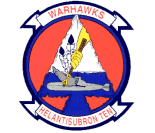HS-10 Warhawks
| Helicopter Anti-Submarine Squadron Ten | |
|---|---|
|
HS-10 insignia | |
| Active | June 30, 1960 - July 12, 2012 |
| Country | United States |
| Branch | US Navy |
| Type | Anti-submarine warfare |
| Role | Fleet Replacement Squadron |
| Part of | Helicopter Anti-Submarine Wing, U.S. Pacific Fleet |
| Garrison/HQ | Naval Air Station North Island |
| Nickname(s) | "Warhawks" |
| Equipment | SH-60F Seahawk |
| Commanders | |
| Current commander | Commander William J. Murphy |
Helicopter Anti-Submarine Squadron 10 (HS-10) is a United States Navy helicopter anti-submarine squadron based at Naval Air Station North Island, San Diego, California. Helicopter Anti-Submarine Squadron 10 (HS-10), a shore-based unit of Helicopter Anti-Submarine Wing, U.S. Pacific Fleet, was commissioned on 30 June 1960 at NALF Imperial Beach, California. HS-10 was relocated to Naval Air Station North Island, San Diego, California on 23 December 1976.
HS-10's mission is to indoctrinate and train pilots, aircrew, and maintenance personnel in carrier based rotary-wing anti-submarine warfare (ASW) aircraft. Since its commissioning, the squadron has trained more than 2,000 pilot, 2,000 aircrew, and 6,450 maintenance personnel in the operation, tactics, and maintenance of Sikorsky SH-3 "Sea King" helicopters. HS-10 closed its chapter on the SH-3H helicopter with more than 70,000 mishap-free flight hours when the last students completed in June 1989. The squadron immediately began operations with the Navy's newest aircraft, the Sikorsky SH-60F "Seahawk," a derivative of the successful Army UH-60 "Blackhawk."
On 1 October 1989, HS-10 assumed the challenge of being the first SH-60F Fleet Replacement Squadron. In 1990, the long-standing squadron nickname of "Taskmasters" was replaced with "Warhawks," illustrating the renewed commitment to training the best and brightest for battle in the newest of "Hawks." Since that time HS-10 transitioned eight entire fleet HS squadrons in addition to the normal replacement pilot/aircrew load. Additionally, the Warhawks have provided training for Navy Helicopter Combat Squadrons (HCS), U.S. Coast Guard personnel in their initial transition to the HH-60J "Jayhawks," and pilots from Germany's Naval Air Arm. As of 23 September 1994, with the disestablishment of HS-12 at Naval Air Field Atsugi, Japan, the "Foxtrot," as the SH-60F has come to be known, has completely replaced the SH-3H in the Pacific Fleet.
In addition to providing training support for numerous organizations, HS-10 has a secondary role of Search and Rescue. In its 38-year history, HS-10 has successfully completed more than 100 rescues of both civilian and military personnel along the coast of Southern California.
Tactics development and evaluation has been a natural role for HS-10, as most of the permanently assigned personnel have significant fleet experience in the ASW and Combat Search and Rescue (CSAR) mission areas. This expertise has been, and will continue to be, instrumental in the development of SH-60F training plans and tactical procedures for the fleet's operational carrier battle groups.
As the armed forces experience a period of downsizing, the capability to effectively operate in the "joint" and "combined" arenas is even more critical. To this end, HS-10 forged ahead with exchange instructor pilots from the U.S. Air Force, Canada, Australia, and Germany.
The U.S. Navy disestablished HS-10 on July 13, 2012.[1]
References
External links
| Wikimedia Commons has media related to Helicopter Anti-Submarine Squadron 10 (United States Navy). |
<references http://www.navy.mil/view_image.asp?id=127606/>
